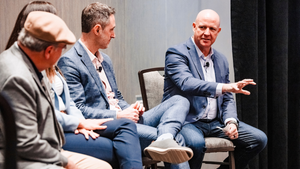Brookshire Launches Customer-Focused SoftwareBrookshire Launches Customer-Focused Software
Brookshire Grocery Co.'s 156 stores are offering more customized product assortments that better reflect local shopper demographics and behavior since the chain went live with SAP for Retail solutions in July. It's more like a store of the community, said John D'Anna, vice president of information technology planning and strategy for Brookshire, based in Tyler, Texas. It helps us focus on
October 20, 2008
JAMES TENSER
LAS VEGAS — Brookshire Grocery Co.'s 156 stores are offering more customized product assortments that better reflect local shopper demographics and behavior since the chain went live with SAP for Retail solutions in July.
“It's more like a store of the community,” said John D'Anna, vice president of information technology planning and strategy for Brookshire, based in Tyler, Texas. “It helps us focus on taking care of the customer, and that includes at the assortment level.”
D'Anna discussed Brookshire's initial experience with the new enterprise software earlier this month in a presentation at the SAP Retail Forum '08 here.
With the implementation, which went live in July after an 18-month planning and implementation process, Brookshire became the first U.S. supermarket chain to successfully launch Walldorf, Germany-based SAP's retail software across its enterprise. SAP for Retail solutions include buying, pricing, category management, forecasting, scorecards, merchandise assortment planning and replenishment.
Brookshire also implemented SAP's POS Data Management application in 2007, as well as SAP's Business Suite family of financial and human resources applications between 2004 and 2006. The chain's commitment to SAP's enterprise resource planning (ERP) solutions — rather than cherry-picking best-of-breed solutions from a variety of software providers — makes it unusual among food retailers.
Asked for an example of how the SAP applications have helped Brookshire deliver more customer-centric store assortments, D'Anna cited waxed paper. “Based on the SAP data, our category managers told us certain stores in southern Louisiana index higher on sales of waxed paper than our signature store in Tyler, Texas,” he said. “It allowed us to increase the merchandise allotment in those stores and gain sales we were previously missing.”
Brookshire's legacy applications, he added, did not afford the company the ability to discover and make even these kinds of merchandising adjustments on a per-store basis.
The implementation of SAP for Retail solutions began with Brookshire's recognition in 2006 that it needed a new business model. For one thing, roughly 130 of its stores were located directly across the street from a Wal-Mart. To better compete, the company set out to bring its systems up to state-of-the-art.
Said D'Anna, “We knew we were behind most retailers when it came to category management. We saw that as an opportunity to leapfrog the industry, and move toward a more customer-centric approach.”
Careful preparation made clear that adopting a state-of-the-art category management discipline would necessitate fundamental changes in how Brookshire runs its business and the way its employees approach their jobs. D'Anna said the company established a “four-tier” change program to address this:
Alter the organizational structure to support category management.
Redefine employee responsibilities, eliminating silos and making category managers responsible for profit performance.
Put the right people in the right jobs.
Change the technology to support the above.
“This wasn't a technology project so much as it was a change management project,” said D'Anna, who outlined how a project team of more than 100, including Brookshire employees and associates of Deloitte Consulting and SAP, planned and carried out the changeover.
John Rooney, principal national practice leader, Deloitte Consulting, New York, described a “hands-on-keyboards” project approach, in which Brookshire employees performed most programming tasks with coaching and mentoring from Deloitte advisors.
To handle this massive and complex activity, the team employed Deloitte's “Industry Print” business process modeling tool, which broke down the project into discrete activities. In all, 18 key interfaces were identified, with the link to POS systems seen as perhaps the most complex and critical piece.
Data conversion was another critical aspect, said D'Anna. “We knew the master data is key. If it's wrong, it's wrong everywhere. We had a lot to convert.” In the end, converted records ran into the millions, with linkages to stores, as well as to frequent-shopper-card and other massive files.
Legacy data cleansing began six months prior to go-live, he said. “Prior to the changeover, our team ran three full conversion mock tests to make sure we had a valid data file before running the real thing.”
The up-front care paid off, he added. “When we did the final conversion, 87,214 [stockkeeping units] were converted, with zero errors.”
The implementation included development of custom portals — called “cockpits” — for senior management, category managers and operations people across the company, allowing them to tap into this data and decision-support tools. “We wanted our [employees] to have their own view into the information,” D'Anna said.
When Brookshire identified limitations in the tools available for managing direct-store-delivery categories, SAP responded well, D'Anna said. “DSD requires frequent master-data and purchase-price changes at the [SKU], store, and effective date level.” In Brookshire's case, that worked out to 50,000 DSD items in 160 stores, supplied by 1,000 DSD distributors.
“We feel like we've laid a foundation for the company for the future,” said D'Anna. “The data's all there.”
About the Author
You May Also Like




